Mental Health Case Study: Nursing Interventions and Ethical Issues
VerifiedAdded on 2022/09/28
|7
|990
|23
Homework Assignment
AI Summary
This homework assignment analyzes a mental health case study, focusing on a patient exhibiting suicidal ideation and symptoms of depression. The student identifies an urgent risk area and proposes a nursing intervention, emphasizing the importance of establishing a therapeutic alliance through effective communication and exploring protective factors. The assignment also addresses a mental health concern, identifying depression based on the case and proposing interventions, such as maintaining hygiene to boost self-esteem. Furthermore, it discusses two legal, ethical, or professional issues that a nurse may encounter when working with the client, highlighting the importance of respecting human rights and obtaining informed consent. The analysis is supported by current literature and references.
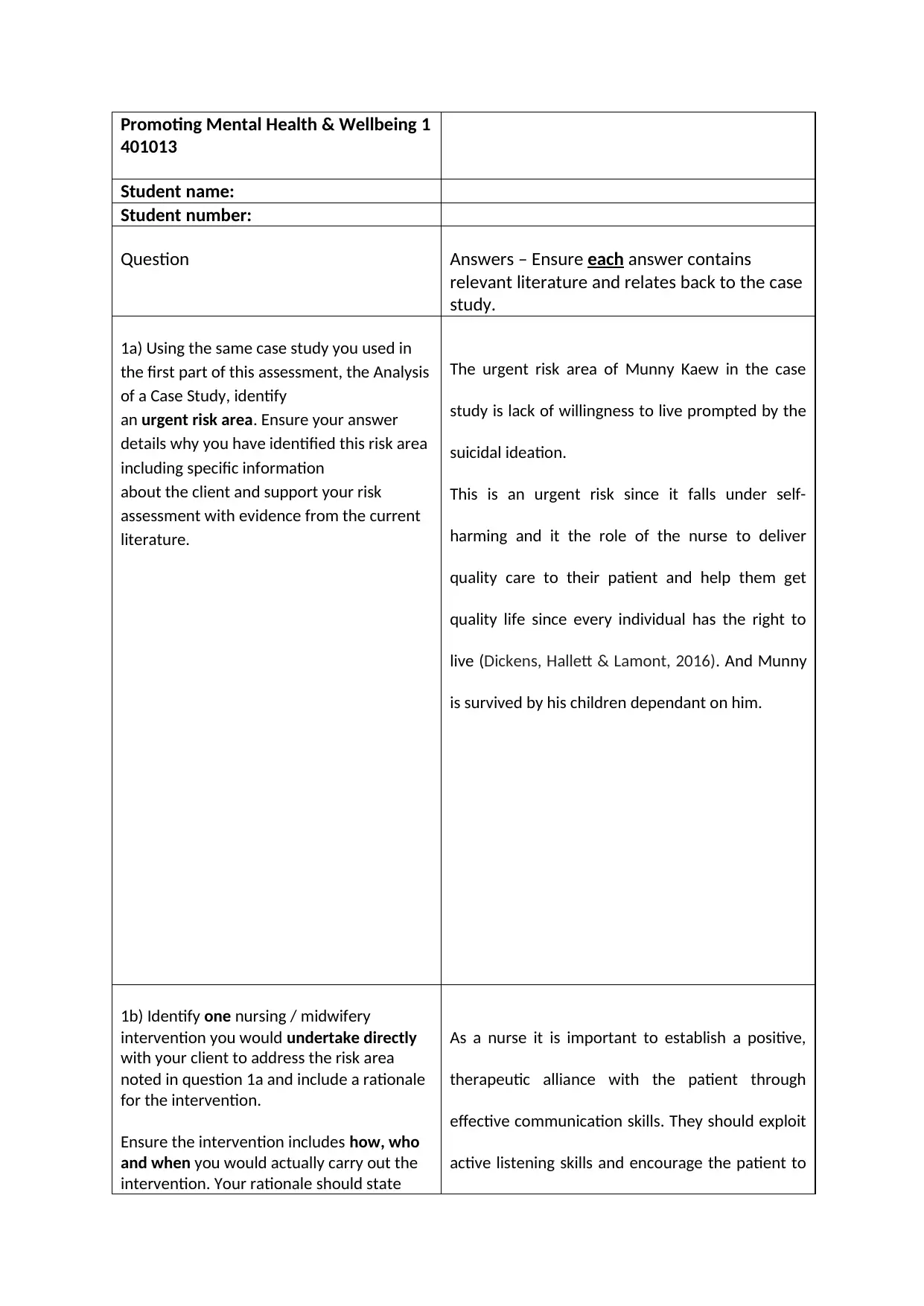
Promoting Mental Health & Wellbeing 1
401013
Student name:
Student number:
Question Answers – Ensure each answer contains
relevant literature and relates back to the case
study.
1a) Using the same case study you used in
the first part of this assessment, the Analysis
of a Case Study, identify
an urgent risk area. Ensure your answer
details why you have identified this risk area
including specific information
about the client and support your risk
assessment with evidence from the current
literature.
The urgent risk area of Munny Kaew in the case
study is lack of willingness to live prompted by the
suicidal ideation.
This is an urgent risk since it falls under self-
harming and it the role of the nurse to deliver
quality care to their patient and help them get
quality life since every individual has the right to
live (Dickens, Hallett & Lamont, 2016). And Munny
is survived by his children dependant on him.
1b) Identify one nursing / midwifery
intervention you would undertake directly
with your client to address the risk area
noted in question 1a and include a rationale
for the intervention.
Ensure the intervention includes how, who
and when you would actually carry out the
intervention. Your rationale should state
As a nurse it is important to establish a positive,
therapeutic alliance with the patient through
effective communication skills. They should exploit
active listening skills and encourage the patient to
401013
Student name:
Student number:
Question Answers – Ensure each answer contains
relevant literature and relates back to the case
study.
1a) Using the same case study you used in
the first part of this assessment, the Analysis
of a Case Study, identify
an urgent risk area. Ensure your answer
details why you have identified this risk area
including specific information
about the client and support your risk
assessment with evidence from the current
literature.
The urgent risk area of Munny Kaew in the case
study is lack of willingness to live prompted by the
suicidal ideation.
This is an urgent risk since it falls under self-
harming and it the role of the nurse to deliver
quality care to their patient and help them get
quality life since every individual has the right to
live (Dickens, Hallett & Lamont, 2016). And Munny
is survived by his children dependant on him.
1b) Identify one nursing / midwifery
intervention you would undertake directly
with your client to address the risk area
noted in question 1a and include a rationale
for the intervention.
Ensure the intervention includes how, who
and when you would actually carry out the
intervention. Your rationale should state
As a nurse it is important to establish a positive,
therapeutic alliance with the patient through
effective communication skills. They should exploit
active listening skills and encourage the patient to
Paraphrase This Document
Need a fresh take? Get an instant paraphrase of this document with our AI Paraphraser
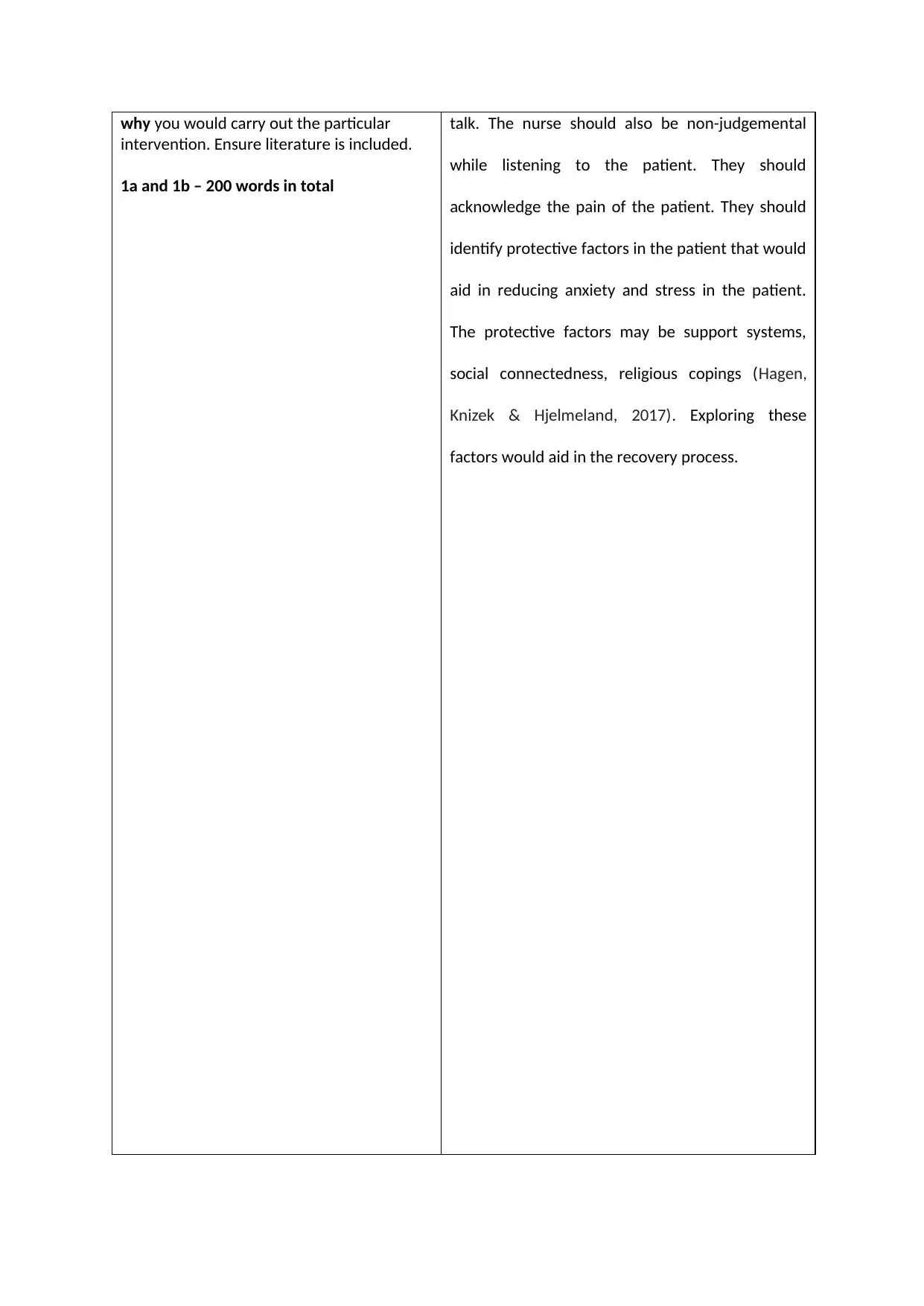
why you would carry out the particular
intervention. Ensure literature is included.
1a and 1b – 200 words in total
talk. The nurse should also be non-judgemental
while listening to the patient. They should
acknowledge the pain of the patient. They should
identify protective factors in the patient that would
aid in reducing anxiety and stress in the patient.
The protective factors may be support systems,
social connectedness, religious copings (Hagen,
Knizek & Hjelmeland, 2017). Exploring these
factors would aid in the recovery process.
intervention. Ensure literature is included.
1a and 1b – 200 words in total
talk. The nurse should also be non-judgemental
while listening to the patient. They should
acknowledge the pain of the patient. They should
identify protective factors in the patient that would
aid in reducing anxiety and stress in the patient.
The protective factors may be support systems,
social connectedness, religious copings (Hagen,
Knizek & Hjelmeland, 2017). Exploring these
factors would aid in the recovery process.
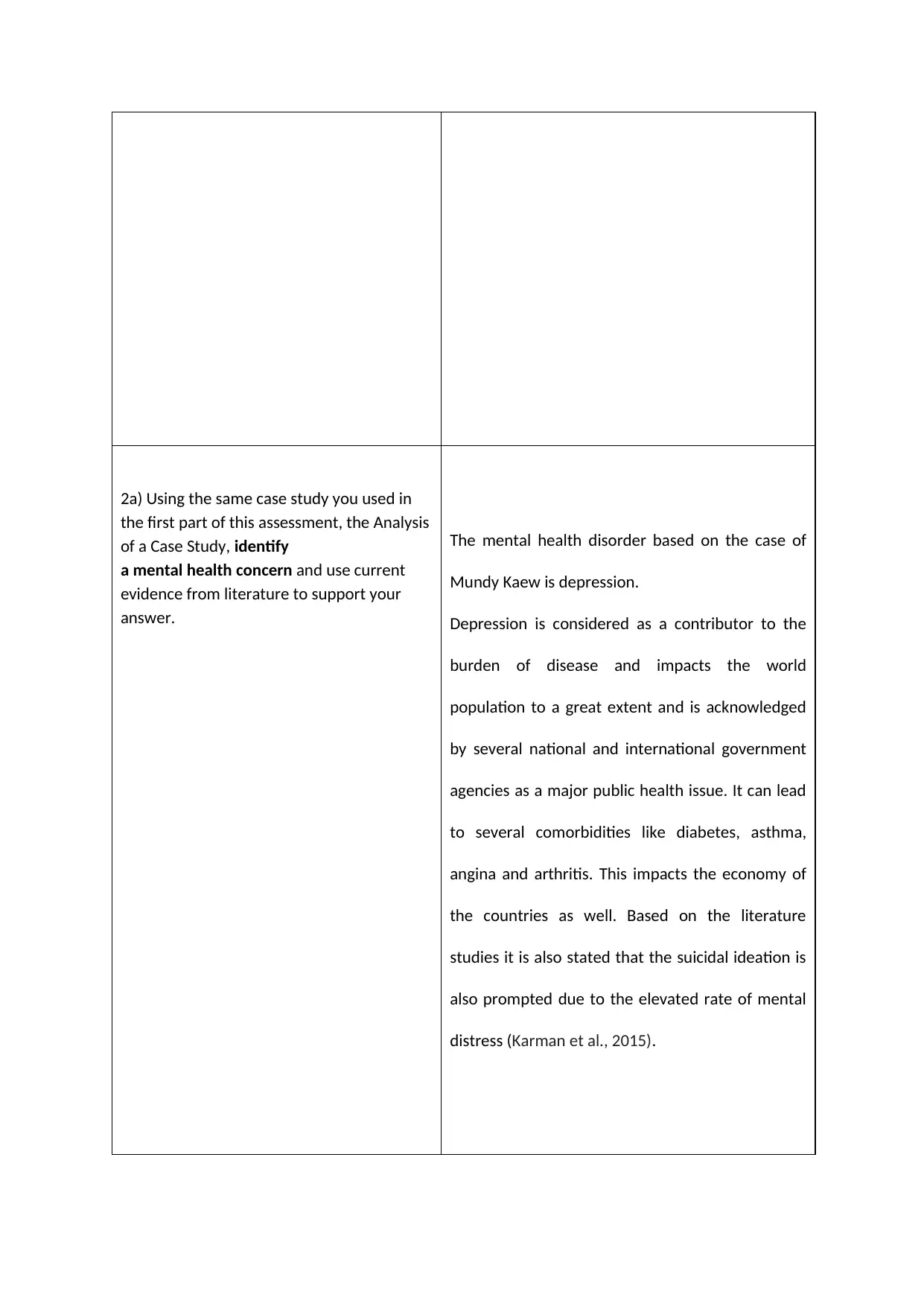
2a) Using the same case study you used in
the first part of this assessment, the Analysis
of a Case Study, identify
a mental health concern and use current
evidence from literature to support your
answer.
The mental health disorder based on the case of
Mundy Kaew is depression.
Depression is considered as a contributor to the
burden of disease and impacts the world
population to a great extent and is acknowledged
by several national and international government
agencies as a major public health issue. It can lead
to several comorbidities like diabetes, asthma,
angina and arthritis. This impacts the economy of
the countries as well. Based on the literature
studies it is also stated that the suicidal ideation is
also prompted due to the elevated rate of mental
distress (Karman et al., 2015).
the first part of this assessment, the Analysis
of a Case Study, identify
a mental health concern and use current
evidence from literature to support your
answer.
The mental health disorder based on the case of
Mundy Kaew is depression.
Depression is considered as a contributor to the
burden of disease and impacts the world
population to a great extent and is acknowledged
by several national and international government
agencies as a major public health issue. It can lead
to several comorbidities like diabetes, asthma,
angina and arthritis. This impacts the economy of
the countries as well. Based on the literature
studies it is also stated that the suicidal ideation is
also prompted due to the elevated rate of mental
distress (Karman et al., 2015).
⊘ This is a preview!⊘
Do you want full access?
Subscribe today to unlock all pages.

Trusted by 1+ million students worldwide
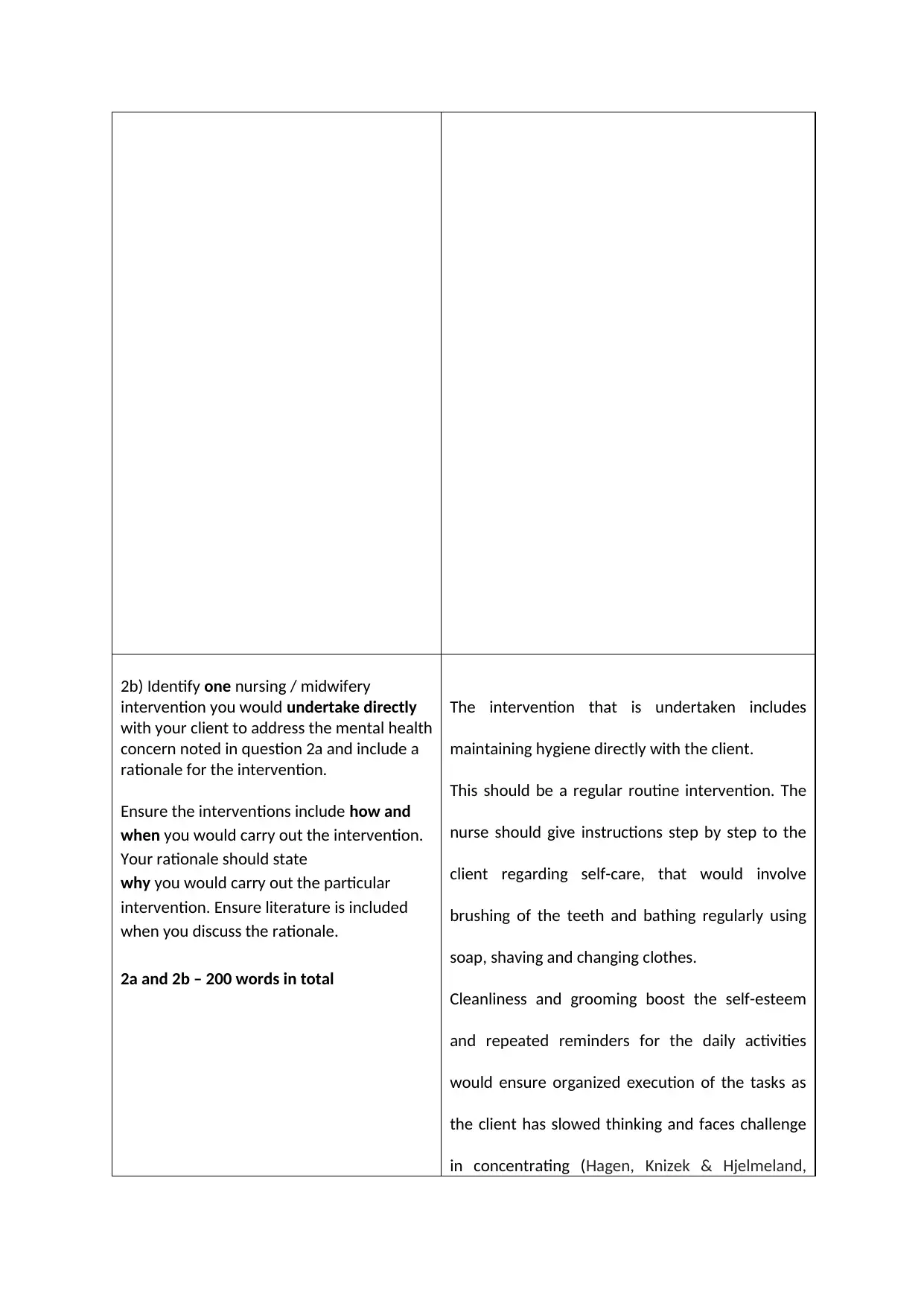
2b) Identify one nursing / midwifery
intervention you would undertake directly
with your client to address the mental health
concern noted in question 2a and include a
rationale for the intervention.
Ensure the interventions include how and
when you would carry out the intervention.
Your rationale should state
why you would carry out the particular
intervention. Ensure literature is included
when you discuss the rationale.
2a and 2b – 200 words in total
The intervention that is undertaken includes
maintaining hygiene directly with the client.
This should be a regular routine intervention. The
nurse should give instructions step by step to the
client regarding self-care, that would involve
brushing of the teeth and bathing regularly using
soap, shaving and changing clothes.
Cleanliness and grooming boost the self-esteem
and repeated reminders for the daily activities
would ensure organized execution of the tasks as
the client has slowed thinking and faces challenge
in concentrating (Hagen, Knizek & Hjelmeland,
intervention you would undertake directly
with your client to address the mental health
concern noted in question 2a and include a
rationale for the intervention.
Ensure the interventions include how and
when you would carry out the intervention.
Your rationale should state
why you would carry out the particular
intervention. Ensure literature is included
when you discuss the rationale.
2a and 2b – 200 words in total
The intervention that is undertaken includes
maintaining hygiene directly with the client.
This should be a regular routine intervention. The
nurse should give instructions step by step to the
client regarding self-care, that would involve
brushing of the teeth and bathing regularly using
soap, shaving and changing clothes.
Cleanliness and grooming boost the self-esteem
and repeated reminders for the daily activities
would ensure organized execution of the tasks as
the client has slowed thinking and faces challenge
in concentrating (Hagen, Knizek & Hjelmeland,
Paraphrase This Document
Need a fresh take? Get an instant paraphrase of this document with our AI Paraphraser
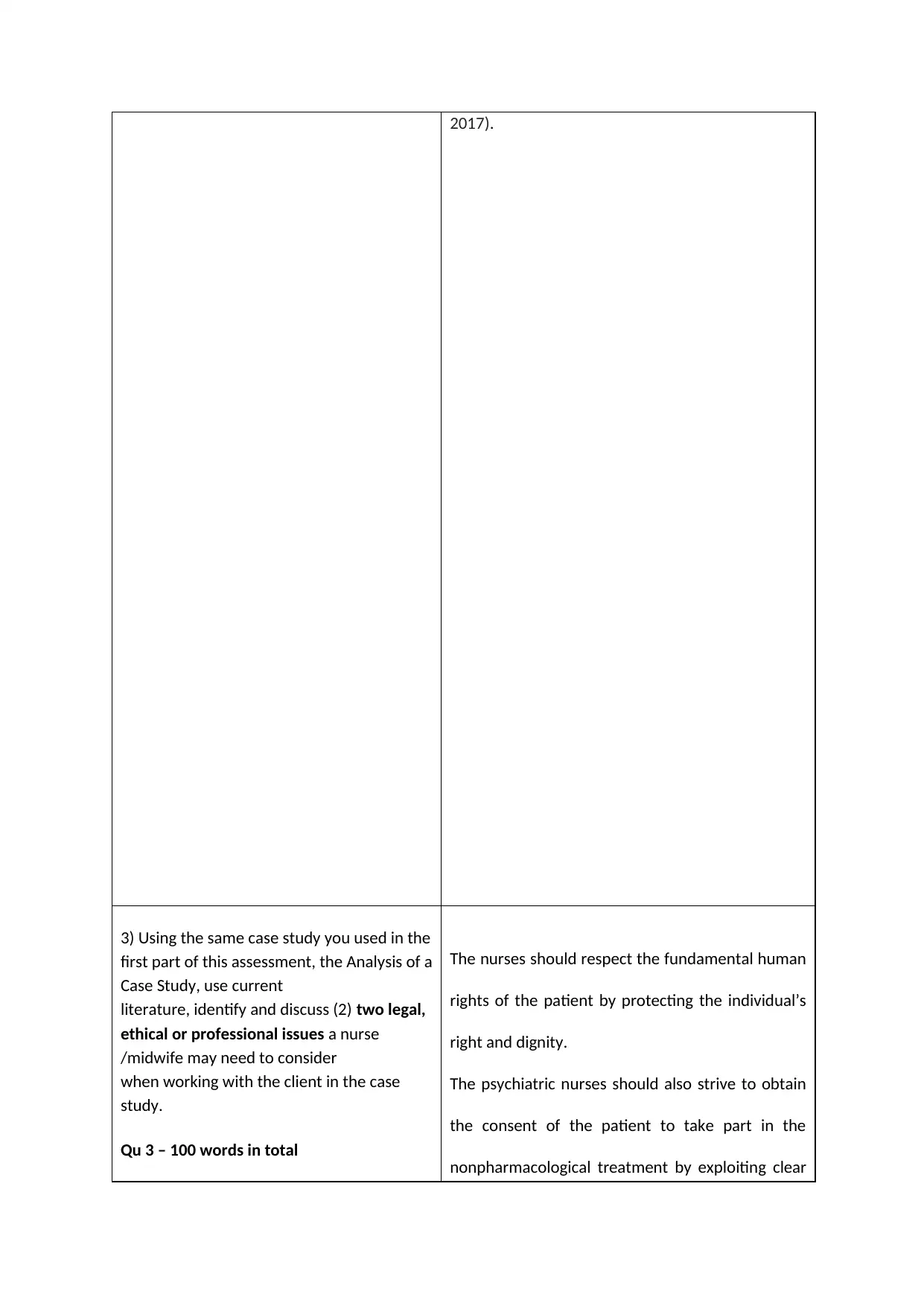
2017).
3) Using the same case study you used in the
first part of this assessment, the Analysis of a
Case Study, use current
literature, identify and discuss (2) two legal,
ethical or professional issues a nurse
/midwife may need to consider
when working with the client in the case
study.
Qu 3 – 100 words in total
The nurses should respect the fundamental human
rights of the patient by protecting the individual’s
right and dignity.
The psychiatric nurses should also strive to obtain
the consent of the patient to take part in the
nonpharmacological treatment by exploiting clear
3) Using the same case study you used in the
first part of this assessment, the Analysis of a
Case Study, use current
literature, identify and discuss (2) two legal,
ethical or professional issues a nurse
/midwife may need to consider
when working with the client in the case
study.
Qu 3 – 100 words in total
The nurses should respect the fundamental human
rights of the patient by protecting the individual’s
right and dignity.
The psychiatric nurses should also strive to obtain
the consent of the patient to take part in the
nonpharmacological treatment by exploiting clear
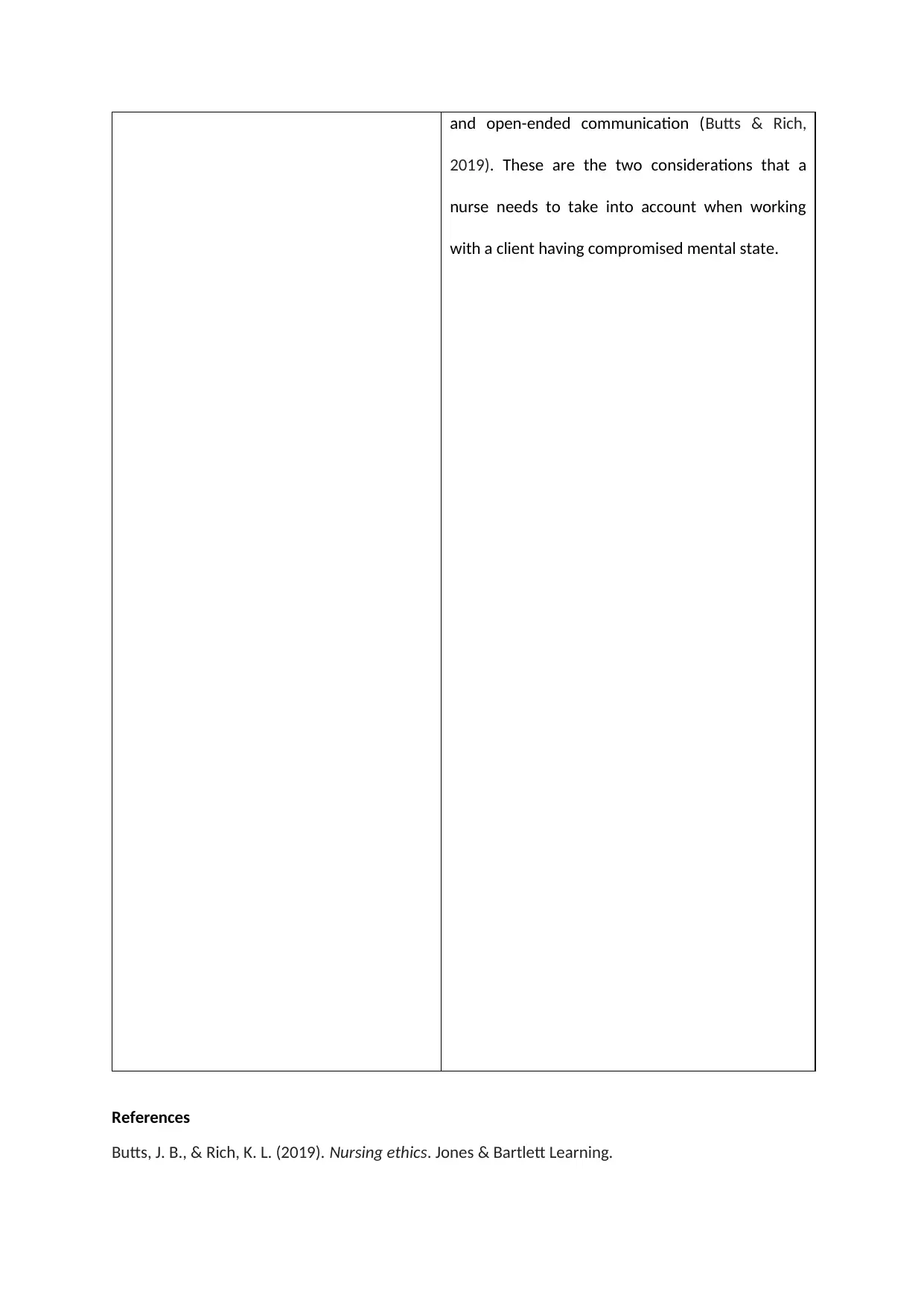
and open-ended communication (Butts & Rich,
2019). These are the two considerations that a
nurse needs to take into account when working
with a client having compromised mental state.
References
Butts, J. B., & Rich, K. L. (2019). Nursing ethics. Jones & Bartlett Learning.
2019). These are the two considerations that a
nurse needs to take into account when working
with a client having compromised mental state.
References
Butts, J. B., & Rich, K. L. (2019). Nursing ethics. Jones & Bartlett Learning.
⊘ This is a preview!⊘
Do you want full access?
Subscribe today to unlock all pages.

Trusted by 1+ million students worldwide
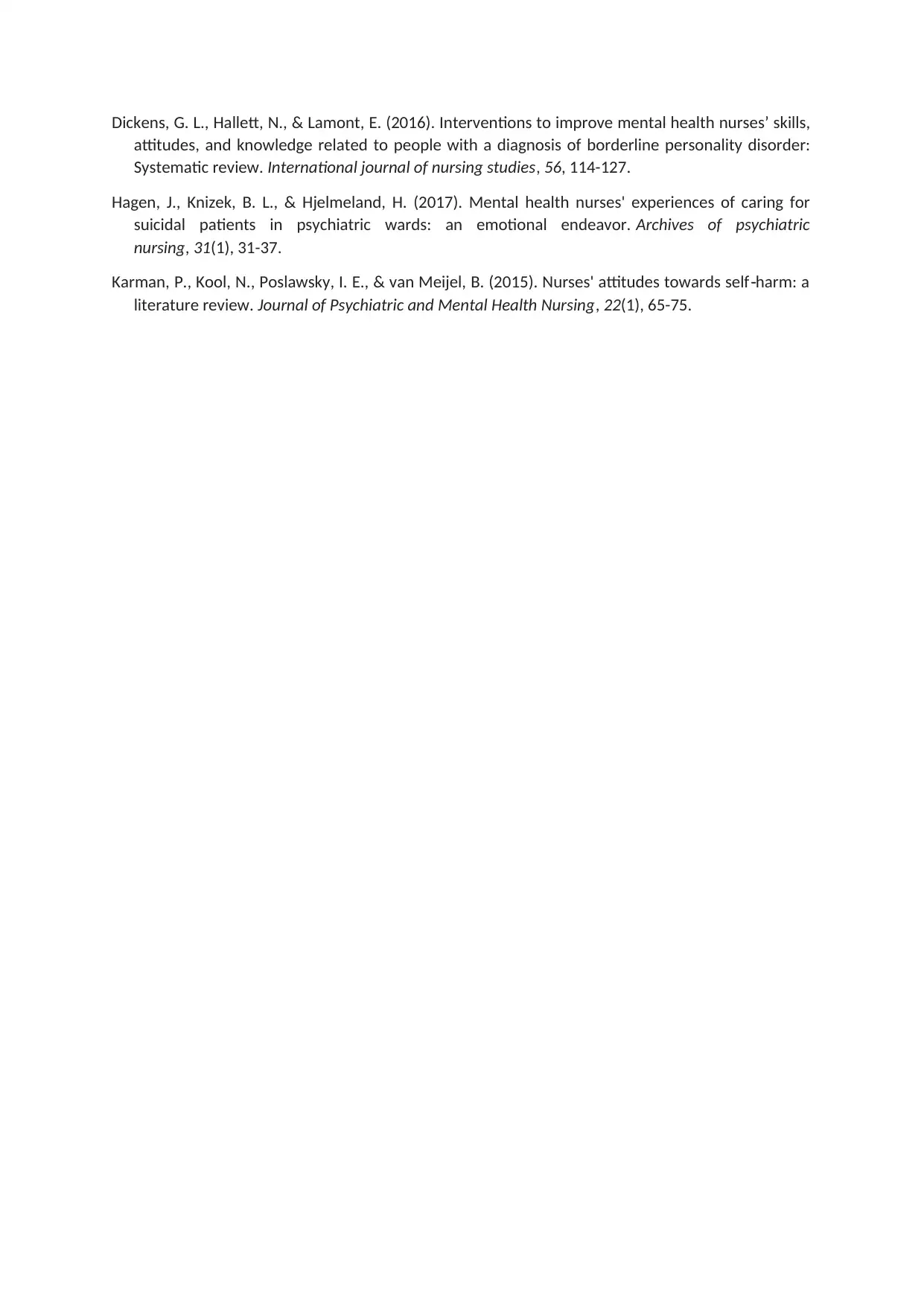
Dickens, G. L., Hallett, N., & Lamont, E. (2016). Interventions to improve mental health nurses’ skills,
attitudes, and knowledge related to people with a diagnosis of borderline personality disorder:
Systematic review. International journal of nursing studies, 56, 114-127.
Hagen, J., Knizek, B. L., & Hjelmeland, H. (2017). Mental health nurses' experiences of caring for
suicidal patients in psychiatric wards: an emotional endeavor. Archives of psychiatric
nursing, 31(1), 31-37.
Karman, P., Kool, N., Poslawsky, I. E., & van Meijel, B. (2015). Nurses' attitudes towards self harm: a‐
literature review. Journal of Psychiatric and Mental Health Nursing, 22(1), 65-75.
attitudes, and knowledge related to people with a diagnosis of borderline personality disorder:
Systematic review. International journal of nursing studies, 56, 114-127.
Hagen, J., Knizek, B. L., & Hjelmeland, H. (2017). Mental health nurses' experiences of caring for
suicidal patients in psychiatric wards: an emotional endeavor. Archives of psychiatric
nursing, 31(1), 31-37.
Karman, P., Kool, N., Poslawsky, I. E., & van Meijel, B. (2015). Nurses' attitudes towards self harm: a‐
literature review. Journal of Psychiatric and Mental Health Nursing, 22(1), 65-75.
1 out of 7
Related Documents
Your All-in-One AI-Powered Toolkit for Academic Success.
+13062052269
info@desklib.com
Available 24*7 on WhatsApp / Email
![[object Object]](/_next/static/media/star-bottom.7253800d.svg)
Unlock your academic potential
Copyright © 2020–2025 A2Z Services. All Rights Reserved. Developed and managed by ZUCOL.




